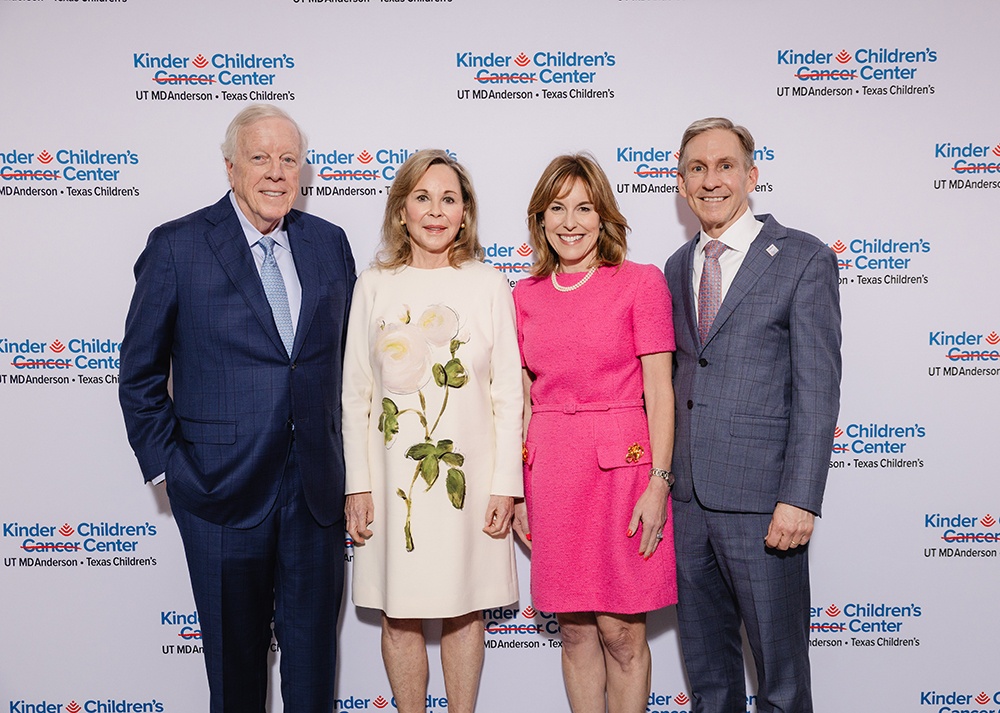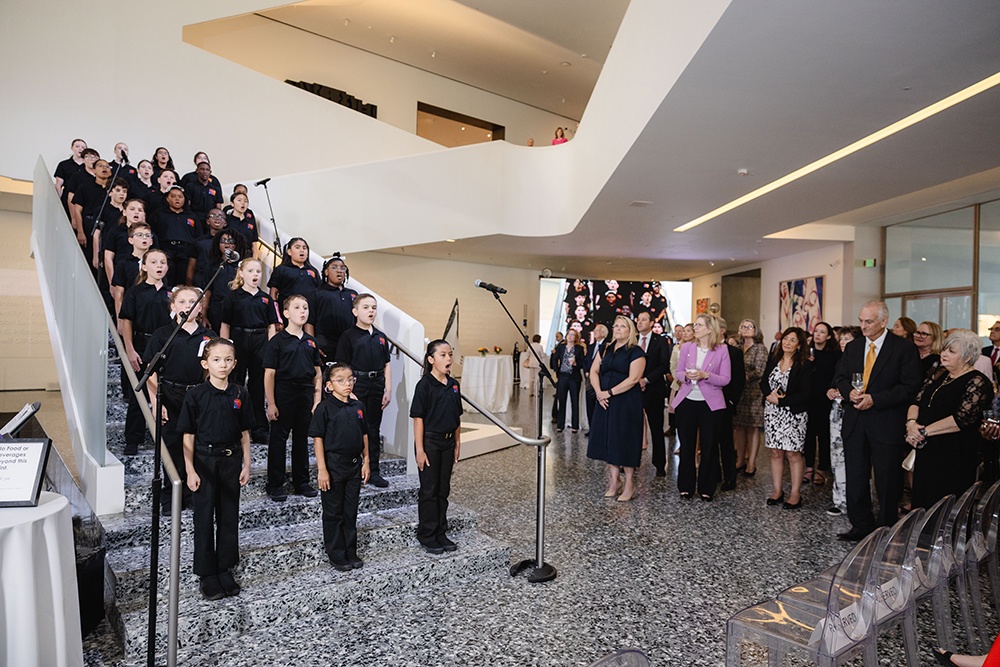The windows down the hall from the operating room scrub sinks at MD Anderson Cancer Center look out at the tower of Texas Children’s Hospital.
Years ago, long before he became MD Anderson’s president, Peter WT Pisters often looked out those windows and thought of the possibilities for creating a massive pediatric oncology center by uniting the programs of his institution and those of Texas Children’s.
“I would be at the scrub sink, scrubbing with another surgeon. I would look out the window, and I would say to the person next to me at the sink, ‘Hey, why don’t we partner with them? They’re amazing,’” Pisters recalled recently.
The synergies were obvious. Both MD Anderson and Texas Children’s treat pediatric cancer, and their programs would fit together like pieces of a puzzle, Pisters thought. But obviousness notwithstanding, a joint project of this sort could never happen because it would require setting aside turf considerations, an alignment of political forces—and an extraordinary amount of time and resources.
“The community wanted something spectacular like this, but somehow it didn’t happen. We don’t know why. They all said it was impossible,” Pisters said.
And yet, last month, the forces aligned and the seemingly impossible project—called Kinder Children’s Cancer Center, a joint venture of the University of Texas MD Anderson Cancer Center and Texas Children’s Hospital—was ushered into existence. When it’s built, it will produce the largest children’s cancer hospital in the U.S. and one of the largest, if not the largest, in the world.


Childhood cancer is rare, making it difficult to answer research questions, which is why pediatric oncologists have learned to set aside turf interests for the greater good. Setting an example for adult cooperative groups, 25 years ago, all pediatric oncology groups—there were four—merged into a single entity, the Children’s Oncology Group (The Cancer Letter, July 15, 2011; Dec. 15, 2000).
An argument can be made that the MD Anderson-Texas Children’s venture is driven by the same rationale that a quarter century ago forged today’s COG out of the merger of Children’s Cancer Group, Pediatric Oncology Group, National Wilms’ Tumor Study Group, and the Intergroup Rhabdomyosarcoma Study Group.
“Even though cancer is the leading killer, by disease, of children in the United States, it’s still quite a rare entity. Any of our specific pediatric cancer types, and even more so, the molecular subtypes, are now becoming even more rare diseases. So, having two academic institutions literally across the street from each other, that care for those same rare patients, from a healthcare implementation perspective, is not an optimal plan,” said Donald William “Will” Parsons, the interim director of the Texas Children’s Cancer and Hematology Center, who is managing the transition to the new joint center together with Richard Gorlick, head of the Division of Pediatrics at MD Anderson.
“From a patient and family perspective, having one unified program that takes advantage of all the resources at Texas Children’s, and also the collaboration with MD Anderson makes sense,” Parsons said to The Cancer Letter. “The challenging aspect is figuring out how to actually make that happen and how to achieve synergy in terms of the clinical trials, in terms of the educational programs, in terms of the laboratory research between the two institutions. And that’s what we are going to be focusing on over these next handful of years.”
Parsons holds the Beverly and Daniel C. Arnold Endowed Chair for Precision Medicine, and is the co-director of the Cancer Genetics and Genomics Program, director of the Center for Precision Oncology, and pediatrician-in-chief at the Dan L. Duncan Comprehensive Cancer Center at Baylor College of Medicine, professor at the Department of Pediatrics, Section of Hematology-Oncology, and Children’s Oncology Group study chair for the NCI-COG Pediatric MATCH trial (The Cancer Letter, July 28, 2017).
MD Anderson’s Gorlick is the department chair at the Department of Pediatrics Patient Care, the Mosbacher Pediatrics Chair, and director of the Department of Pediatric Sarcoma Research Laboratory.
Gregory Reaman, the founding chair of the Children’s Oncology Group, said that the new Texas hospital is an example of the type of collaboration needed in pediatric oncology.
Said Reaman:
As aptly stated by Dr. Parsons, cancer in children is rare, and when defined by emerging molecular subtypes, even the more common cancers observed in children are becoming increasingly rare, further enforcing the need for the type of collaboration that can result from the unification of these two highly respected programs, each recognized for disparate strengths and historical accomplishments.
What will likely result as the largest pediatric cancer hospital in the U.S. will serve not only patients and families in the Houston area, but the potential research and educational synergies should have far reaching impact nationally and internationally, particularly given the broader context of pediatric oncology to include infants, children, adolescents, and young adults.
Given the academic, institutional, and financial entanglements, the extent of collaboration will be enormous, but this is how pediatric oncologists operate. My personal association with the skills and characters of the two program leaders charged with implementation of this initiative predicts a successful outcome.
It will be interesting to follow the course of this initiative, which could serve as a model for expanding collaborative opportunities in other geographic areas of the U.S., where consolidation of pediatric cancer programs could also accelerate advances in clinical care and research.
Reaman, who is not involved in the nascent Houston institution, is an emeritus professor of pediatrics at the George Washington University School of Medicine and Health Sciences and the scientific director of the NCI’s Childhood Cancer Data Initiative.
The anatomy of a joint venture
The idea of creating a pediatric center stayed with Pisters through the evolution of his career.
He added management roles at MD Anderson, went away to become president and CEO of University Health Network of Toronto, then returned to Houston as president of MD Anderson (The Cancer Letter, Nov. 3, 2017).
“When I started in this role, within 30 minutes of being given the immense responsibility, I thought to myself, ‘I want to do something really big for pediatric cancer,’” Pisters said to The Cancer Letter. This made sense on many levels, including the personal.
As a surgeon specializing in sarcomas, Pisters had done many surgeries on pediatric patients.
Of course, the collaboration would not be easy.
Though the institutions are contiguously located on the Texas Medical Center campus, MD Anderson is a part of the UT System, while Texas Children’s is in a partnership with Baylor College of Medicine. Faculty credentials and faculty affairs at Texas Children’s go through Baylor College of Medicine.
Pisters said that institutions started to work more closely together during the pandemic.
“During the pandemic here in Houston, the Texas Medical Center CEOs got much closer. In 2020, we were meeting every morning at 6:30 on Zoom,” Pisters said. “We were sharing insights on communication, on PPE, on policies, on masking, on vaccination, and so on. Tighter relationships really formed as a byproduct of that. That included Mark Wallace, the CEO at Texas Children’s Hospital, and me.”
There’s nothing more inspiring for a researcher than to see individuals that you are helping in the same environment. Imagine what it would be like for these researchers to see a child with cancer on their way into the lab. There can’t be a more inspiring stimulus.
Peter WT Pisters
Pisters started to see that a collaboration in pediatric oncology might have become feasible.
“I went around to my team, and I said, ‘Hey, I think we can do something really big with Texas Children’s,’” Pisters said. “I often go to my team for advice and insight and perspective, and I float tons of ideas with them.”
Of course, this was an obvious no-go.
“They looked back at me, and they said, ‘Hey, Peter, that is a waste of time.’ And they gave numerous reasons why they felt that Texas Children’s would never do that. And I listened to all of that, but in the end, I said, ‘That’s okay. I appreciate your perspective on this, but I’m going to try.’”
Next, in the fall of 2021, Wallace came over to MD Anderson for lunch.
“And over lunch, I said, ‘Hey, Mark, I love your institution. You do amazing work. We have a pediatric program. How about if we did this…’” Pisters outlined his idea in broad strokes.
“And Mark looked at me and he goes, ‘That’s a brilliant idea.’ We talked about how that could happen. By the end of it, we shook hands, and we said, ‘Let’s do it.’
“It was a one-hour conversation over lunch. That was it,” Pisters said. “It was a pivotal hour in the history of MD Anderson, Texas Children’s, and for children with cancer.”
Next, Pisters stopped by the office of Omer Sultan, the just-arrived senior vice president and chief financial officer of MD Anderson.
“I left the lunch, and I went into Omer’s office, and I looked at him and I said, ‘You won’t believe what just happened.’ He was new on the job and didn’t know exactly what to think of what I was saying.”
Having agreed on the vision, Pisters and Wallace needed to figure out the funding.
MD Anderson is planning to invest about $10 billion in the Texas Medical Center, suburban areas of Houston, and in Austin.
From a patient and family perspective, having one unified program that takes advantage of all the resources at Texas Children’s, and also the collaboration with MD Anderson makes sense.
Donald William “Will” Parsons
“This actually wasn’t part of the $10 billion,” Pisters said. “We recognized that we needed a novel way to think about that, and we also felt that we had a compelling case, that was, arguably, certainly first in the nation, type of collaboration, and that there would be tremendous emotional appeal locally.”
This was also a dream of a philanthropy project—to build what would likely be the largest pediatric cancer hospital in the U.S.
“This is what I would describe as a once-in-a-generation philanthropic opportunity. These things just don’t happen every two or three years,” Pisters said. “It’s maybe once every 25 or 30 years that two institutions try to do something this spectacular.”
Pisters and Debra F. Sukin, who succeeded Wallace as president and CEO of Texas Children’s, approached Rich and Nancy Kinder, whose foundation provides major gifts focused on enhancing urban green spaces, education, and quality of life in the Houston area.
As of the end of 2024, the foundation distributed more than $621.4 million of the over $850 million in grants committed.
Rich Kinder, the foundation’s chairman, is the executive chairman of Kinder Morgan Inc., one of the largest energy infrastructure companies in North America.
“Nancy Kinder has been on our Board of Visitors for 26 years,” Pisters said. “And, as she said recently, she was waiting for just the right project, and this is it.”
The Kinders gave $150 million to the project, which will be called the Kinder Children’s Cancer Center.
“They are well respected in our community, and they will set a tone and momentum,” Pisters said. “And I know that many other people in our community are saying, ‘Wow, look at what they did. We want to help, too.’”
The hospital will be built on the 6700 block of Main Street, where it will replace a surface parking lot and the defunct SureStay Plus Hotel. The new pediatric cancer center will be connected to Texas Children’s by a skybridge.
More money will be needed—a total of $600 million to $700 million for the building, Pisters estimates.
Another $300 million to $400 million would be needed for endowed positions, recruitment, and programming.
“And then, we have an agreed-upon plan to reinvest in the facility over time, so that there’s a business plan that includes reinvestment by both institutions, to create sustainability in the long run,” Pisters said.
How long will this take?
“Well, I’m always an optimist, so I’ll say 2031,” Pisters said.
The puzzle pieces
The two institutions have very different scopes of practice, with few overlaps, officials say.
Texas Children’s is one of the largest pediatric hospitals in the country, and its hematology and oncology program treats a broad range of patients. Altogether, the hospital treats about 2,000 new hematology and oncology patients each year, and about 700 of them are oncology patients, Parsons estimates.
“We see patients from all across the cancer spectrum: newly diagnosed patients, relapsed patients, and those with both common and rare diseases,” Parsons said.
“For more than 70 years, Texas Children’s has been a place where breakthroughs happen,” said Debra F. Sukin, president and CEO of Texas Children’s. “Our renowned Cancer and Hematology Center has always been committed to solving the unsolvable and pushing the boundaries of what’s possible, and this historic partnership with MD Anderson is a once-in-a-generation opportunity to accelerate those efforts and set a new global standard in the fight against childhood cancer. Together, we are creating a groundbreaking program whose advanced care, clinical research, education and training will be guided by one goal: eradicating pediatric cancer.”
MD Anderson’s pediatric program is significantly smaller. Pisters estimates that MD Anderson sees about 400 new cases per year. Though the institution sees a broad spectrum of patients, it tends to be more specialized.
“They have excellent and specialized practice in which the majority of their pediatric patients are older children—adolescents to young adults with treatment-refractory cancers, building on the access to clinical trials that MD Anderson has,” Parsons said.
“So, between the two of those, the combination of our two cancer centers will surely comprise the largest pediatric cancer and hematology center in the United States by patient numbers. Partnering with MD Anderson will allow us to strategically continue to expand our horizons beyond our primary focus across Houston and Texas, to increasingly include a national and international scope as well,” Parsons said.
How would the size and scope of the new institution compare with St. Jude Children’s Research Hospital, a super brand that has massive resources and exercises great influence on pediatric cancer research and cancer care worldwide?
“What I know, having visited there many times before, is that they’re a great institution. They do amazing work. I think that we will have the ability to have greater size and scale,” Pisters said. “Our goal is not necessarily to outcompete an established competitor that does great work, but to sit side-by-side as two great institutions committed to the country, and, also, to find creative ways to eradicate children’s cancer around the world.”
Recognizing that AYA patients are different
Pisters said that as a sarcoma surgeon, he recognized the challenges of taking care of pediatric and young adult and adolescent patients in an environment designed for adults.
Said Pisters:
We have a strong AYA program, and they have a strong one next door. And the way we thought about it is to consider the needs of the patient. Imagine if we had a 17-year-old girl here with osteosarcoma, and we were to ask her, “Are you comfortable inside the environment of Texas Children’s Hospital?”
Without question, she would say, “No, I don’t fit in here. These children are not like me.”
If we were to bring that same child into the MD Anderson, ask the same question, that child would say, “I don’t fit in here, either. These people all have gray hair. I don’t like Lawrence Welk.”
So, what we’re really talking about is building a dedicated facility. We have a separate entrance for AYA patients. We have dedicated floors, only for AYA patients.
And if we were to do that, these adolescents and young adults would see a purpose-built environment. As you might imagine, the decor would be different there.
The playlist would certainly be a lot different.
Transition to Kinder Children’s Cancer Center


Source: Kinder Children’s Cancer Center.
In early 2026, all the pediatric patients from MD Anderson are going to go to Texas Children’s for their care, Parsons said.
Pisters said the goal is to form a genuine 50/50 joint venture.
“The way to think of this is that Elite Hospital A is partnering with Elite Hospital B to build Elite Hospital C. And the business model is a new company that will be created. And then there’ll be a board with 50/50 representation from Elite A and Elite B,” Pisters said. “And then the board will conduct an international search for a leader. And that’s how this will work. The care will be provided by Texas Children’s Hospital, because that’s their core competency.
“The governance will be 50/50, as I’m describing, and then there’ll be joint reinvestment to create a sustainable business model.”
The transition will be organized in two work streams.
“One we’ve been talking about is the design and building of a new cancer center for children. A second work stream, that will run in parallel to that, is the unification of the clinical programs, which will take place in early 2026,” Pisters said. “So, early next year, our children’s cancer hospital will close, and the children in the outpatient clinics that we have will be integrated.
“Those children will receive care in a dedicated pediatric environment, which will be better for them. Our faculty will provide care and will be members of the medical staff at Texas Children’s Hospital.”
The MD Anderson employees at the children’s cancer hospital will be given the option to transfer to Texas Children’s, Pisters said.
At that point, the institutions will compare their programs and policies.
“We’ll be comparing our policies, side by side, and then saying, ‘Hey, what represents best practice?,’” Pisters said. “And then we’ll be adopting, what we agree together, represents best practice. So, I anticipate that some policies will evolve in a way that represents the evolution of best practice for children with cancer.”
After the UT System board and the Texas Children’s board approved creation of the Kinder Children’s Cancer Center, Pisters got together with Paul Klotman, the CEO of Baylor College of Medicine, to discuss plans for the new hospital and to begin to “co-create research synergies.”
“We talked about how important this was going to be for both institutions and our unified research efforts,” Pisters said. “We know that we have a lot to do. We know there’s amazing talent next door at Baylor College of Medicine. We have talented research teams also, and the possibilities of bringing them together in labs that will be in the new building, is very exciting to us.
“What we’re talking about are the PhD scientists and the physician scientists, who focus on pediatric cancer. And then making sure that in the future, say, in 2030 or 2031, they’re in dedicated labs working together inside the new building. There’s nothing more inspiring for a researcher than to see individuals that you are helping in the same environment.
“Imagine what it would be like for these researchers to see a child with cancer on their way into the lab.
“There can’t be a more inspiring stimulus.”









